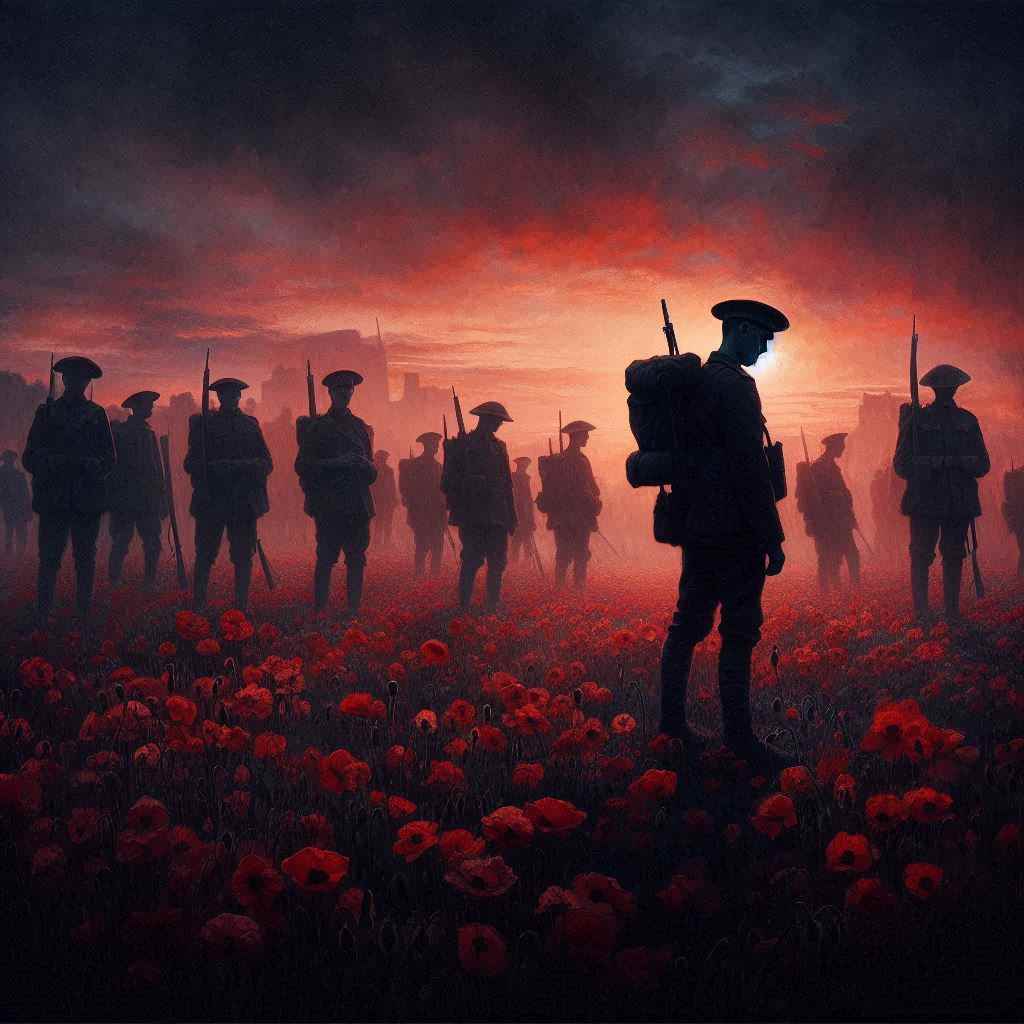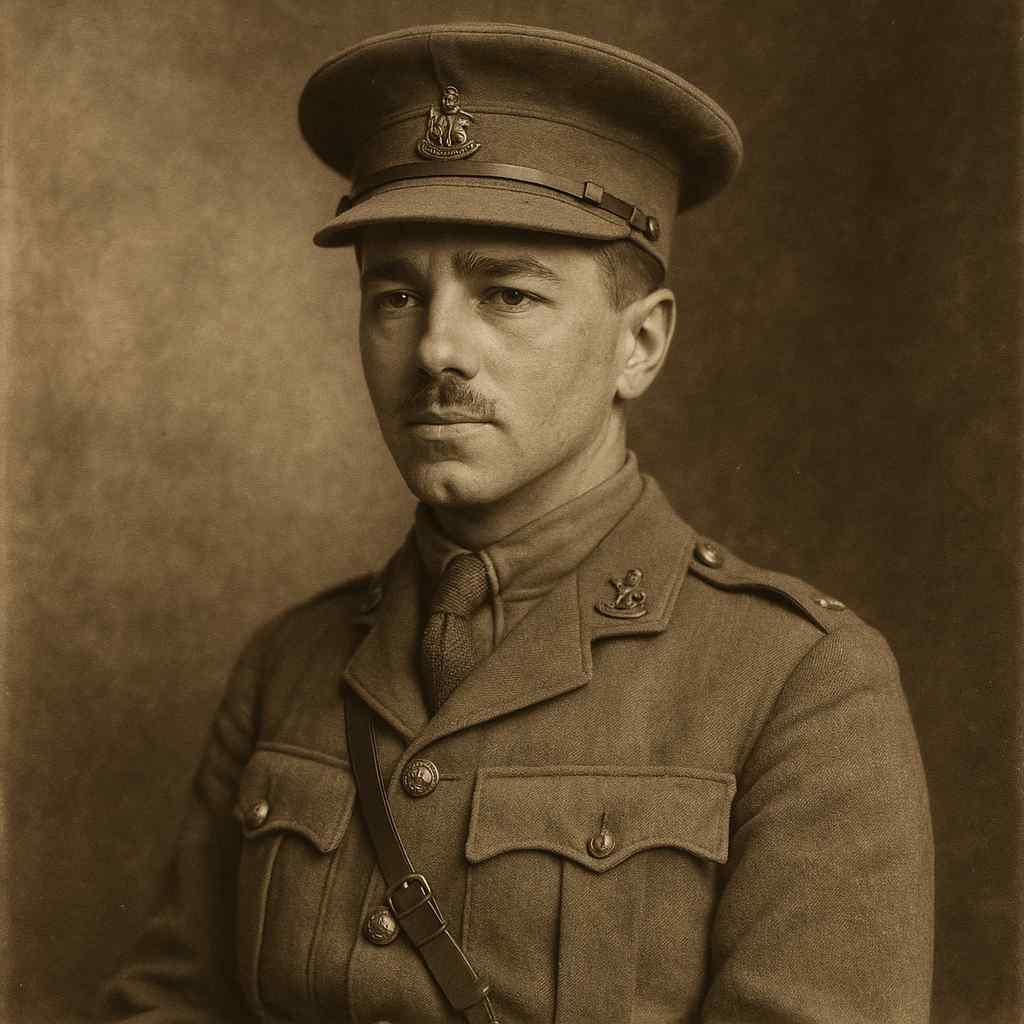Anthem for Doomed Youth
Wilfred Owen
1893 to 1918

What passing-bells for these who die as cattle?
— Only the monstrous anger of the guns.
Only the stuttering rifles' rapid rattle
Can patter out their hasty orisons.
No mockeries now for them; no prayers nor bells;
Nor any voice of mourning save the choirs,—
The shrill, demented choirs of wailing shells;
And bugles calling for them from sad shires.
What candles may be held to speed them all?
Not in the hands of boys, but in their eyes
Shall shine the holy glimmers of goodbyes.
The pallor of girls' brows shall be their pall;
Their flowers the tenderness of patient minds,
And each slow dusk a drawing-down of blinds.
Wilfred Owen's Anthem for Doomed Youth
Introduction
Wilfred Owen's "Anthem for Doomed Youth" stands as a poignant testament to the horrors of World War I and a scathing indictment of the romanticization of war. This sonnet, composed in 1917 while Owen was recuperating from shell shock at Craiglockhart War Hospital, masterfully juxtaposes the traditional rituals of mourning with the stark realities of death on the battlefield. Through its intricate use of imagery, sound devices, and structural elements, the poem creates a powerful critique of the futility of war and the loss of an entire generation of young men.
Structure and Form
Owen's choice of the sonnet form is particularly significant in "Anthem for Doomed Youth." The poem follows a hybrid structure, combining elements of both Petrarchan and Shakespearean sonnets. The octave (first eight lines) adheres to the ABAB CDCD rhyme scheme typical of a Shakespearean sonnet, while the sestet (final six lines) employs a EFFEGG rhyme scheme more reminiscent of a Petrarchan sonnet. This blending of forms reflects the tension between tradition and modernity that permeates the poem's themes.
The volta, or turn, occurs at the beginning of the sestet with the question "What candles may be held to speed them all?" This shift marks a transition from the auditory imagery of battle to the visual imagery of mourning, emphasizing the contrast between the violent deaths of soldiers and the somber, quiet grief of those left behind.
Imagery and Symbolism
Owen's use of imagery is particularly striking in its subversion of traditional funeral rites. The "passing-bells" of the opening line are replaced by the "monstrous anger of the guns," while the "stuttering rifles' rapid rattle" serves as a grotesque substitute for prayers. This juxtaposition of sacred rituals with the profane realities of war underscores the poem's central theme: the dehumanization of soldiers in modern warfare.
The auditory imagery in the octave creates a cacophonous soundscape of battle, with "guns," "rifles," and "wailing shells" replacing the solemn sounds of mourning. The "shrill, demented choirs" of shells offer a chilling parallel to church choirs, further emphasizing the perversion of religious symbolism in the context of war.
In the sestet, Owen shifts to visual imagery, focusing on the symbols of mourning at home. The "candles" traditionally used in funeral services are reimagined as the "holy glimmers of goodbyes" in the eyes of young boys, while the "pallor of girls' brows" serves as a metaphorical pall or funeral cloth. These images poignantly capture the collective grief of a society losing its youth to war.
Sound Devices and Musicality
The poem's title, "Anthem for Doomed Youth," sets up an expectation of musicality that Owen skillfully manipulates throughout the piece. The use of alliteration and assonance creates a rhythmic quality that mimics both the sounds of battle and the solemnity of a funeral dirge. For example, the repetition of the "o" sound in "Only," "orisons," and "voice of mourning" creates a mournful tone, while the harsh consonants in "stuttering rifles' rapid rattle" evoke the chaotic sounds of gunfire.
Owen's use of onomatopoeia, particularly in phrases like "patter out" and "wailing shells," further enhances the auditory experience of the poem, immersing the reader in the soundscape of war. This auditory emphasis serves to highlight the disconnect between the idealized notion of a heroic death and the brutal reality of dying in battle.
Thematic Analysis
At its core, "Anthem for Doomed Youth" is a powerful anti-war statement. Owen, drawing from his own experiences in the trenches, presents a scathing critique of the notion of the "glorious death" in battle. The opening line, "What passing-bells for these who die as cattle?" immediately establishes the dehumanizing nature of modern warfare, reducing soldiers to mere animals led to slaughter.
The poem also explores the theme of collective grief and the inadequacy of traditional mourning rituals in the face of mass casualties. The absence of "mockeries," "prayers," and "bells" for the fallen soldiers underscores the impersonal nature of their deaths and the inability of society to properly honor their sacrifice.
Furthermore, Owen touches on the generational impact of the war, emphasizing the youth of those who died. The "boys" with glimmers in their eyes and the "girls" with pale brows represent the lost potential and the shattered futures of an entire generation. The final line, "And each slow dusk a drawing-down of blinds," serves as a poignant metaphor for the daily ritual of mourning that has become commonplace in wartime society.
Literary Context and Influence
"Anthem for Doomed Youth" must be considered within the broader context of World War I poetry and the literary movement it spawned. Owen, along with poets like Siegfried Sassoon and Isaac Rosenberg, was part of a group that sought to convey the harsh realities of war, in stark contrast to the patriotic verse that dominated the early years of the conflict.
Owen's work, including this poem, marks a significant shift in war poetry, moving away from romanticized notions of heroism and sacrifice towards a more critical, realistic portrayal of the human cost of conflict. His influence can be seen in subsequent anti-war literature and poetry, cementing his place as one of the most important voices of his generation.
Conclusion
Wilfred Owen's "Anthem for Doomed Youth" stands as a masterpiece of war poetry, skillfully combining formal structure with innovative imagery and sound devices to create a powerful indictment of war. Through its subversion of traditional funeral imagery and its stark portrayal of the realities of battle, the poem forces readers to confront the true nature of modern warfare and its devastating impact on both individuals and society.
Owen's ability to blend the personal with the universal, drawing on his own experiences to create a work of lasting significance, ensures that "Anthem for Doomed Youth" remains relevant and moving more than a century after its composition. As we continue to grapple with the human cost of conflict in our own time, Owen's words serve as a poignant reminder of the futility of war and the enduring power of poetry to speak truth to power.
This text was generated by AI and is for reference only. Learn more
Want to join the discussion? Reopen or create a unique username to comment. No personal details required!



Comments
No comments yet. Be the first to comment!